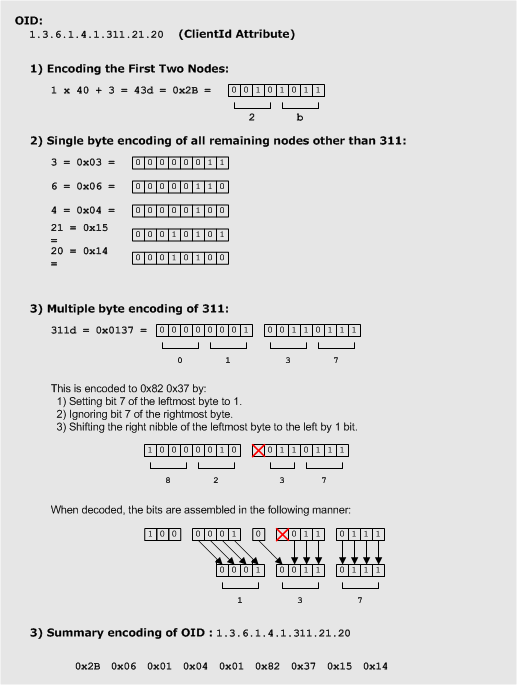OBJECT IDENTIFIER
The OBJECT IDENTIFIER data type is encoded into a TLV triplet that begins with a Tag value of 0x06. Each integer of a dotted decimal object identifier (OID) is encoded according to the following rules:
- The first two nodes of the OID are encoded onto a single byte. The first node is multiplied by the decimal 40 and the result is added to the value of the second node.
- Node values less than or equal to 127 are encoded on one byte.
- Node values greater than or equal to 128 are encoded on multiple bytes. Bit 7 of the leftmost byte is set to one. Bits 0 through 6 of each byte contains the encoded value.
These points are shown by the following illustration.

The following example shows how the ClientId attribute is encoded in a certificate request.
06 09 ; OBJECT_ID (9 Bytes)
| 2b 06 01 04 01 82 37 15 14 ; 1.3.6.1.4.1.311.21.20
31 4a ; SET (4a Bytes)
30 48 ; SEQUENCE (48 Bytes)
02 01 ; INTEGER (1 Bytes)
| 09
0c 23 ; UTF8_STRING (23 Bytes)
| 76 69 63 68 33 64 2e 6a ; vich3d.j
| 64 6f 6d 63 73 63 2e 6e ; domcsc.n
| 74 74 65 73 74 2e 6d 69 ; ttest.mi
| 63 72 6f 73 6f 66 74 2e ; crosoft.
| 63 6f 6d ; com
0c 15 ; UTF8_STRING (15 Bytes)
| 4a 44 4f 4d 43 53 43 5c ; JDOMCSC\
| 61 64 6d 69 6e 69 73 74 ; administ
| 72 61 74 6f 72 ; rator
0c 07 ; UTF8_STRING (7 Bytes)
63 65 72 74 72 65 71 ; certreq